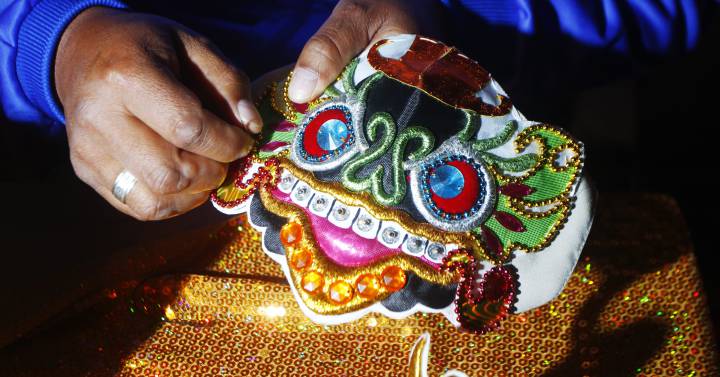"It hurts us a lot, it's like living with a sword stuck in our hearts," says Alfonso Nahuincha with a certain melancholy, from his home in Puno, a city located in the southern Andean region of Peru, facing Lake Titicaca, the navigable body of water highest in the world (3,812 meters above sea level).
His words sound sincere and bring an echo that goes back centuries.
MORE INFORMATION
White flags in Valle del Sol
A unique teacher for a high school
Losing loved ones twice and resisting
Since the pandemic caused by covid-19 reached those heights, towards mid-March as in all of Peru, his trade as an embroiderer of costumes for the rich folklore of Puno has dramatically paralyzed.
The many contracts it had to make or rent them were suspended.
And his craftsman soul also felt the blow.
When the wave comes
On July 15 came the biggest wave.
Due to the pandemic overflow, the Fiesta de la Virgen de la Candelaria in 2021 was suspended, the largest celebration in this region, which takes place at the beginning of February and brings together thousands of dancers and people from the country and the world.
That it was even declared Intangible Cultural Heritage of Humanity by Unesco in 2014.
Alfonso then reacted in a creative and somewhat unexpected way to resist: he transformed the ornate mask worn by the Diablada dancers, one of the most spectacular dances in this country, into a mask to protect himself from contagion.
An almost thousand-year-old tradition was, suddenly, to be transformed into that sanitary outfit that is used today practically all over the planet.
Alfonso Nahuincha with one of the chinstraps that he himself made with motifs from the Diablada Puno.
Juan Carlos Cisneros
"I am making 400 and I have already managed to sell about 60," he says.
She began to promote them among people who belong to the dancers 'associations, embroiderers or among citizens who, for several months, will not be able to see the dancers' crews pass through the streets or the lavish contests that, during the party, are.
This is the largest closed venue in the city of Puno where, during the Indigenous Dance Contest, up to more than 100 groups can perform, each of which can have about 1,000 members.
At the Candelaria Festival of this year 2020, which was held almost at the edge of the quarantine, 121 groups were presented in this area, with the most diverse dances.
In the Contest of Costumes of Lights, where the groups of Diablada, or Morenada and Caporales (other Puno dances) perform, the groups this year were 85. They entered the scene by hundreds causing the astonishment and devotion of always, for the immense and overflowing paraphernalia that they wear, full of armor, masks and even gold threads.
A part now dances in the chinstraps.
An almost thousand-year-old tradition was, suddenly, to be transformed into that sanitary outfit that is used today practically all over the planet
All this is now suspended, as are the festivals that are the job market for the more than 110 embroiderer workshops in Puno, considered the Capital of Peruvian Folklore for its wasteful folk wealth.
"It fell on us like a bucket of cold water," adds Alfonso, from this city where the temperature sometimes drops below 0 degrees.
An emotional wound
The loss for Alfonso is not only monetary, but also emotional.
"For me it is my life, what I want, and for this I have to endure this time," he says without losing an air of hope.
They are not words of circumstance.
Puno and the entire Peruvian highlands, like the Bolivian one (especially in Oruro), cannot be understood without the Virgin
Mamita
Candelaria and her party.
"Like any cultural event, this is a game, and now we cannot play," says Edwin Nahuincha, another master costume embroiderer, who has not ventured into the chinstrap business.
The game began from the Colony when the Spanish came to these lands with their Catholic traditions and found a world that had other spiritual references.
A Diablada costume in all its splendor.
It consists of a mask, back, cuirass, pants and boots.
When the Festival of the Virgen de la Candelaria in Peru, or the Oruro Carnival in Bolivia, unfolds normally, they are the life of the party.
Juan Carlos Cisneros
The
devils
of the Diablada dance, for example, are not the typical western demons that so far scare some.
Rather, they refer to an ancient pre-Hispanic deity still identified today as the Anchanchu, Muqui or Chinchilico, who lives inside the mines.
To her, the pre-Hispanic man made offerings that, according to Alfonso, could be alpaca fetuses.
In an article published in the
Harvard Review of Latin America
, Miguel Rubio, director of the Yuyachkani theater group (we are remembering, in Quechua), one of the most representative of Peru, points out that the offerings were made with zampoñas music.
And with masks made of ceramic that had taruca (Andean deer) horns on top.
When the conquerors encountered this ritual and this character, they thought it was a version of the old Satan.
But no.
It was a deity that was part of the Aymara universe, unknown to them.
In this worldview there are the
Alajpacha
, the kingdom of light located in the upper part;
the
Manqapacha,
the kingdom of darkness, located at the bottom.
In the middle is the
Akapacha,
where man lives.
The Anchanchu, which is small like a goblin, lives in the Manqapacha and can be evil.
Although according to the mask master Edwin Loza, quoted by Rubio, in order to live well and not disturb him, one has to seek a balance between the forces above and those below, through offerings to the Earth and its spirits.
To scare away the supposed devil, in the 16th century the Jesuits would have taught the natives of Juli (a city near Puno) a dance that had an angel and that faced the demons.
Until now, in the Diablada an angel appears dancing with a curved sword (generally represented by a woman).
Only in reality there is no such combat.
The devils are part of the ritual, of the game as Edwin would say, between the Alajpacha, the Akapacha and the Manqapacha.
Moreover, the Virgin of Candelaria would represent the Pachamama (mother Earth) in the Aymara and Quechua world, so that when she is honored with these characters, a syncretism is staged that culturally resisted the onslaught of the Conquest.
Embroidering again
The same thing happened to the embroiderer Yolanda Chambi as to Alfonso Nahuincha.
She had numerous contracts to rent or sell costumes for the Diablada, the Morenada, and other dances.
One for the Fiesta de San José in Cusco, which is celebrated on March 19;
another for the feast of the Lord of Torrechayoc in the city of Urubamba (near Cusco), agreed for May 15.
"We dropped everything, we were helpless and we did not know what to do," he says, also from his home in Puno.
Anguish ran through her for a few weeks, until one day walking down the street with her 24-year-old daughter Shesly, she made her notice that everyone was wearing chinstraps.
Why didn't they start, she suggested, transferring the motifs of the masks to them.
Yolanda Chambi with one of her ornamental masks made by herself to save the hard times.
She has started selling them to make up for the losses she has incurred due to the suspension of all folkloric festivals in Peru.
Juan Carlos Cisneros
They did it and, according to Yolanda, “people were surprised and liked it”, so they were able to throw a financial oxygen balloon at their workshop, Titán de Los Andes, where the whole family works, as did their parents and before her grandparents.
Because it is a trade that is inherited, for generations, and that consists of knowing how to embroider costumes with delicacy and imagination.
A Diablada costume for men — with a mask, cape, jacket, cuirass, trousers, boots — requires fine work.
The mask can be made of brass or other material;
the rest of the clothing, synthetic fiber or velvet.
At the same time, they usually have stone inlays, sometimes of high value.
Depending on the size, its price can reach up to 2,000 soles (472 euros).
The rent for a popular party can cost between 400 and 700 soles (96 and 170 euros), for about three days, taking into account the complexity of the costume and what it cost to make.
Obviously, the sale of chinstraps with motifs from the Diablada, or the Morenada, does not reach those levels in any way.
Hopefully, they sell for between 60 and 120 soles (less than 30 euros), and there is not much demand yet.
The rental of the outfit for a popular party can cost between 96 and 170 euros.
The chinstraps, hopefully, are sold at 30 euros and there is still not much demand
Like Alfonso, Yolanda offered them to those who have a closer link with the Fiesta de la Candelaria, such as the members of the Blocks that make up the gigantic dance groups.
A single block can have 120 dancers and she, on her pilgrimage to preserve her trade, managed to sell them to members of the so-called Bellavista and Quirquincho de Puno Blocks.
The masks don't die
In a last contact, Alfonso tells that, at last, the dancers and embroiderers associations have agreed that on February 2, 2021, despite the suspension of the great party, they will go to the Church of San Juan Bautista in Puno to perform tribute to the Virgen de la Candelaria, whose image is there.
They will do it with chinstraps, embroidered hats and keeping their distance.
"I'm preparing for that," he says, because he will be one of those who will make those short outfits and masks with which he will keep the tradition alive.
Attendees will carry, no longer on their entire face but only between their nose and mouth, the trail and face of the Anchanchu, and probably other pre-Hispanic deities that float in the cultural atmosphere of Peru.
And even from the devils that came from Spain.
Because in 2005, the Catalan researcher Jordi Rius y Mercadé stated that the Ball de Diables, so popular in Catalonia, would have been taken to America to evangelize the indigenous people.
Perhaps to show them who the devil was who now survives in the chinstrap.
Only for them it was (and is) more like part of the game of life.
You can follow PLANETA FUTURO on Twitter and Facebook and Instagram, and subscribe to our newsletter here







